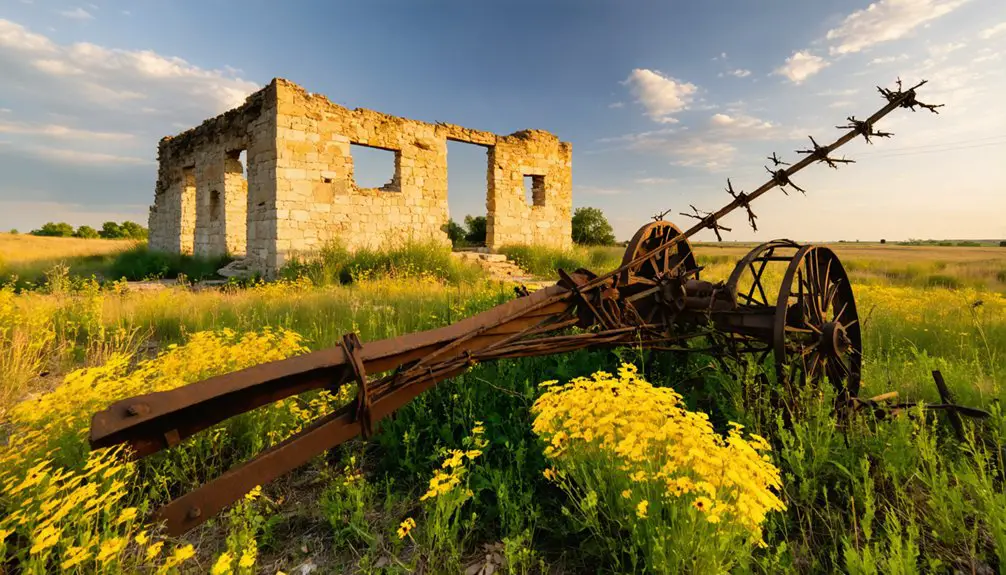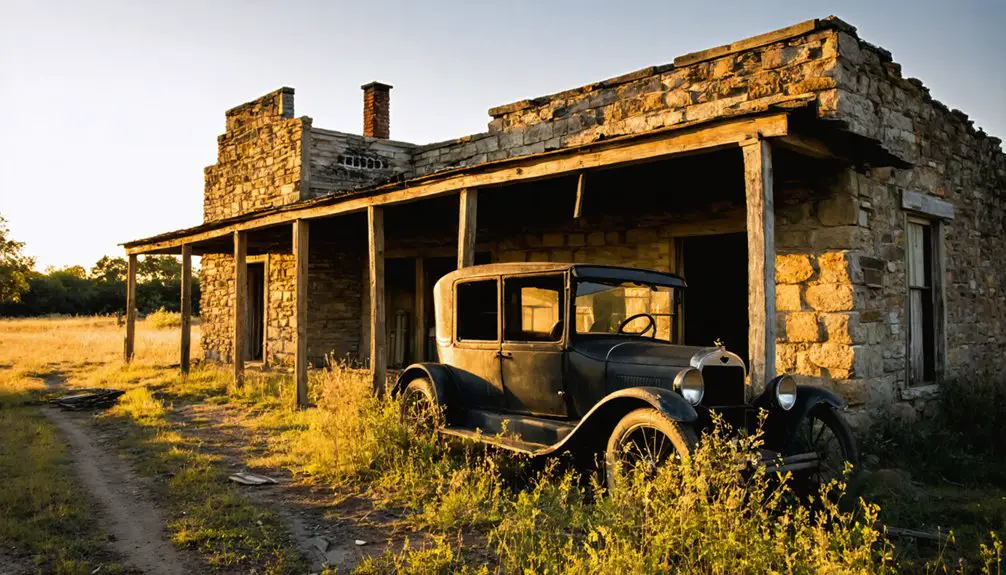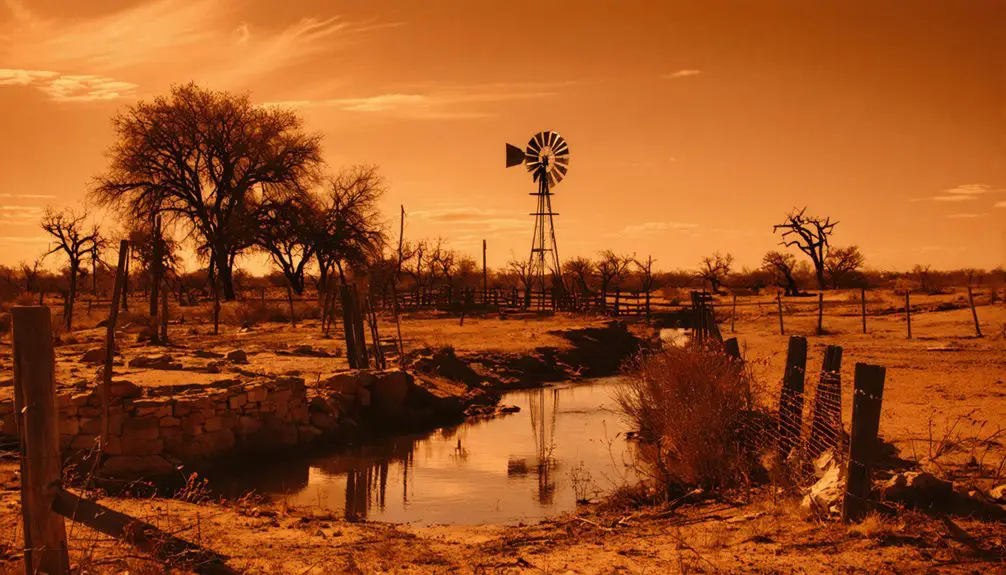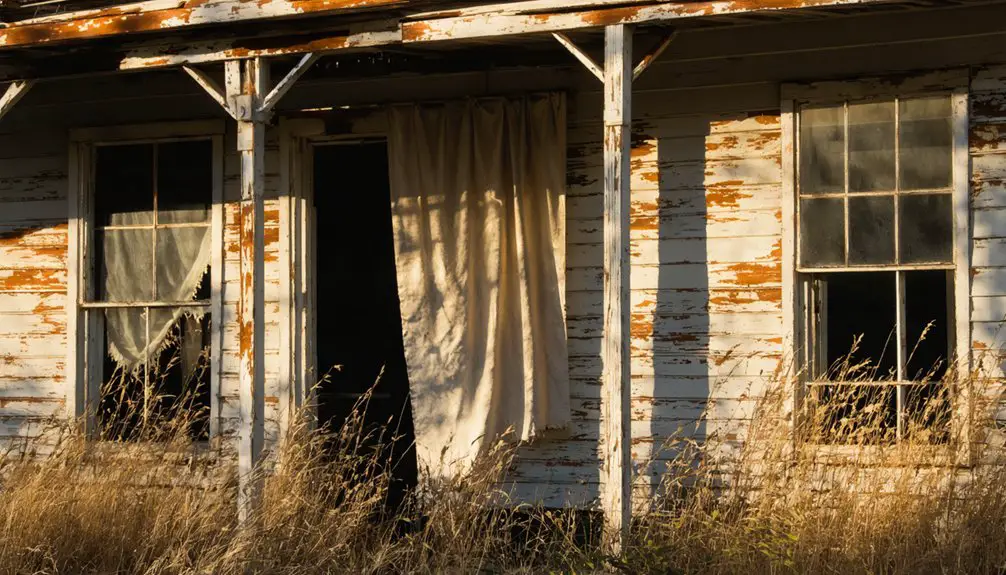You’ll find Currey’s Creek, an 1847 frontier settlement, nestled in Texas Hill Country’s Blanco County. Judge W.E. Jones, Samuel B. Patton, and the Lawhon brothers helped establish this once-bustling community, which thrived on sheep ranching and milling operations until the early 1900s. While Indian raids and harsh frontier conditions ultimately led to its decline, you can still trace its history through deteriorating structures on private ranch land, where limestone hills meet spring-fed waters.
Key Takeaways
- Currey’s Creek was established in 1847 by Samuel B. Patton in Blanco County, Texas, growing to over 100 residents by the 1850s.
- The settlement featured a general store, post office, and mills, serving as a hub for farming and ranching activities.
- Native American raids and violence during 1865-1866 resulted in 163 deaths, contributing to the town’s eventual abandonment.
- Today, the ghost town site exists on private ranch land with deteriorating structures and possible cemetery plots remaining.
- The settlement’s location along Currey Creek and limestone hills influenced its development before becoming a ghost town.
Origins of Currey’s Creek Settlement
While Texas was still in its early years of statehood, the settlement of Curry’s Creek took root in 1847 when Samuel B. Patton established the first homestead in what was then Blanco County.
The settlement patterns followed the typical mid-19th century Texas frontier expansion, with Anglo-American families moving westward in search of opportunity and independence. Like many small Texas towns of that era, the community developed around agricultural activities, with farming and ranching serving as the economic foundation. By the late 1850s, the growing settlement had reached over one hundred residents as more families were drawn to the area.
Pioneer Families and Early Leadership
As Currey’s Creek settlement took shape, prominent families emerged to forge the community’s character and governance.
You’ll find Judge W.E. Jones at the heart of pioneer governance, alongside his wife Hezziah and seven sons who’d later join the Texas Rangers. The Jones family’s dedication to frontier justice came at a price when son Frank fell in the line of duty in 1893. A general store established by Dock Garlington and Wilt Stokes in 1878 became a central meeting point for the community’s leaders.
The Lawhon brothers, Jesse and John, established deep roots in the community’s family dynamics. Like many settlers in Texas during 1836, these families faced constant dangers from raids. While Jesse served as an overseer until his death in 1855 during Native American conflicts, John focused on developing the lower creek’s agricultural foundation.
Samuel B. Patton’s leadership as the first Blanco County judge further strengthened the settlement’s administrative framework, blending civic duties with the practical demands of frontier life.
Life Along the Creek’s Banks
You’d find pioneer families along Curry’s Creek engaged in daily tasks of drawing water, tending riverside gardens, and managing livestock that grazed the fertile banks.
While the creek provided essential resources for farming and milling operations, settlers had to carefully position their homesteads above the flood line to avoid seasonal overflows. In the 1920s, the discovery of rich oil deposits transformed the quiet creek settlement into a bustling community of 300 residents.
Like the town of Old Alton Bridge, only scattered remnants and a cemetery mark where this once-thriving community stood. The waterway’s edge presented constant challenges, from mosquito-borne illnesses to predatory wildlife, yet remained central to the community’s survival as both water source and transportation corridor.
Daily Pioneer Activities
Living along Currey’s Creek in the mid-1800s demanded a delicate balance between sustenance and security from the settlers. Your pioneer chores would’ve included gathering firewood, fetching creek water, and hunting wild game while staying vigilant against potential raids.
Daily routines revolved around managing livestock, maintaining homestead infrastructure, and working the fields. Settlers often consulted historic trail maps to navigate the challenging terrain while performing their daily tasks. Many families relied on Judge Patton’s leadership as the first county judge to resolve disputes and maintain order. You’d find yourself multitasking between productive labor and defense duties, often joining other settlers in tracking stray horses or participating in Texas Rangers activities.
Large families worked together, sharing responsibilities across neighboring homesteads. As an overseer or settler, you’d trade surplus goods with travelers while ensuring your family’s survival through careful resource management and maintaining strong ties with nearby settlers through mutual aid and shared hardships.
Water and Farm Life
The life-sustaining waters of Currey’s Creek shaped every aspect of pioneer farming and settlement along its banks.
You’d find homesteads strategically positioned near the water, taking advantage of fertile floodplain soils while keeping structures safely elevated from seasonal floods. Creek irrigation sustained crops like corn and cotton, while livestock drank directly from the flowing water.
The creek’s baseflow, fed by limestone springs, provided reliable water even during Central Texas’s notorious dry spells. Like the spring-fed Medina River, the natural springs ensured a consistent water supply year-round.
You’d see early settlers practicing careful water conservation, managing precious resources through simple diversion channels and manual watering methods. They’d drill supplementary wells near the creek banks and construct barns using local timber.
Despite occasional challenges from sediment and bacteria levels, the creek’s mineral-rich waters enhanced soil nutrients, supporting the community’s agricultural success.
Creek Settlement Dangers
While settlers found precious water resources along Currey’s Creek, they also faced deadly dangers that transformed daily life into a constant struggle for survival.
You’d have found yourself contending with devastating Kiowa and Comanche raids, where warrior parties exploited the creek’s natural cover to launch surprise attacks. The dense brush and forested banks that sheltered your homestead could quickly become your enemy, concealing up to 600 warriors ready to strike. The region became especially dangerous after U.S. troops withdrew during the Civil War.
Your settler resilience would’ve been tested by isolation, minimal military protection, and raid strategies that left you largely defending yourself. With Fort Belknap’s soldiers spread thin, you’d face the grim reality that many settlers did – watching your neighbors abandon their creek holdings or fall victim to raids that claimed 163 lives in 1865-1866 alone.
Frontier Challenges and Survival

As settlers established homesteads around Curry’s Creek in 1847, they confronted harsh frontier realities that demanded extraordinary resilience and resourcefulness.
You’d find pioneer families like the Pattons demonstrating remarkable survival strategies, from building their own log cabins to defending against Native American raids. Life centered around self-reliance in this untamed Texas Hill Country, where you’d need to master everything from agriculture to basic medicine.
- You’d face constant threats from Indian attacks, like the one that claimed Jesse Lawhon’s life in 1855.
- Limited medical care meant treating injuries and illnesses yourself.
- You’d rely on community support through churches and informal law enforcement.
- Basic technology like steam-powered cotton gins improved your chances of success.
- Isolation and poor roads meant you’d need to stockpile essential supplies.
Economic Activities and Local Industries
Survival skills that pioneers honed in frontier life laid the groundwork for Curry’s Creek’s economic development.
You’ll find agricultural sustainability was achieved through diverse activities including farming along the creek, sheep ranching introduced by George Wilkins Kendall, and cotton processing at the local gin built in 1853.
Industrial diversification emerged through crucial milling operations.
The rise of diverse milling enterprises formed the backbone of early industrial growth in frontier settlements.
William Jones’s sawmill and John S. Hodges’s combined saw and grist mill supported the community’s woodcutting and grain processing needs.
Robison’s gristmill served double duty as a social center, hosting a Masonic lodge.
The settlement’s commerce flourished with a post office operating from 1863 to 1900, while nearby mining towns influenced regional trade through company stores and scrip systems.
This economic vitality supported over 100 residents until decline began in the 1880s.
Notable Historical Events and Figures

You’ll find Currey’s Creek’s early history marked by significant challenges, including Judge W.E. Jones’s dramatic imprisonment during General Woll’s 1842 Mexican invasion of San Antonio and Jesse Lawhon’s tragic death at the hands of Native Americans in 1855.
The settlement’s pioneer families left lasting legacies, with Judge Samuel B. Patton becoming Blanco County’s first judge and the Jones family contributing seven sons to the Texas Rangers.
The area’s dramatic frontier experiences were further highlighted when Frank Jones, following his family’s tradition of service, lost his life as a Texas Ranger on the Mexican border in 1893.
Early Mexican Conflicts
Mexican military tensions near Currey’s Creek intensified during the early 1830s, culminating in the Battle of Velasco where Texian settlers clashed with Mexican forces over a disputed cannon.
The skirmishes you’d witness reflected a growing pattern of Texian resistance against Mexican authority, with casualties mounting on both sides. In the following years, you’d find the region embroiled in escalating conflicts as Native American tribes aligned with Mexican interests against the expanding Texas settlements.
- Mexican forces lost 5 soldiers with 16 wounded at Velasco
- Texian resistance resulted in 7 dead and 14 wounded
- Captain Vicente Córdova’s 1838 rebellion united Mexican and Native American forces
- Kickapoo and Caddo tribes conducted raids supporting Mexican interests
- Border tensions ultimately contributed to the Mexican-American War’s outbreak in 1846
Pioneer Families’ Notable Achievements
Through their pioneering spirit and determination, the founding families of Currey’s Creek established a vibrant frontier community that shaped early Texas Hill Country development.
You’ll find remarkable pioneer achievements in Samuel B. Patton’s civic leadership as the first Blanco County judge, while his sons helped govern the growing settlement.
The Robison family’s gristmill doubled as the area’s Masonic lodge, chartered in 1858, creating a crucial social hub. Judge William E. Jones and John S. Hodges built essential sawmills, while Parson Daniel Rawls, an Old Three Hundred settler, constructed the county’s first cotton gin.
Perhaps most significantly, George Wilkins Kendall’s introduction of sheep ranching diversified the local economy.
These familial legacies established Currey’s Creek as a self-sufficient community of over 100 residents by the late 1850s.
Native American Raid Impact
During the turbulent 1830s, Comanche war parties led by Chief Peta Nocona released devastating raids on the Currey’s Creek settlement and surrounding Texas Hill Country communities.
The Comanche tactics involved swift attacks on isolated homesteads, leading to significant loss of life and the capture of women and children. Settler narratives tell of brutal encounters near Lost Creek, where young captives were dragged and shot, forever changing the region’s history.
- Raids targeted vulnerable frontier families, leaving devastated homesteads
- Children and women were often taken as prisoners, some integrated into Comanche society
- Notable captive Cynthia Ann Parker later became mother to famous Chief Quanah Parker
- Attacks prompted increased militia and Texas Ranger presence in the area
- These violent encounters shaped regional policies and frontier defense strategies
Geographic Features and Natural Resources

Nestled within Kendall County’s Edwards Plateau region, Currey’s Creek Ghost Town sits along its namesake waterway approximately three miles south of Kendalia, Texas. The area’s distinctive landscape features include rolling limestone hills and clear, spring-fed waters that once sustained early settlers.
You’ll find three branches of Currey Creek converging here, creating an essential 15-mile watercourse that shaped the settlement’s development. The creek’s ecological significance remains evident today through its riparian corridor, where native wildflowers bloom in spring and diverse wildlife thrives.
The limestone-rich terrain provided building materials for settlers, while the perennial stream supported agriculture and livestock. Today, you can explore this heritage along the half-mile Currey Creek Trail, where the preserved natural environment offers a glimpse into the region’s untamed past.
Community Development and Infrastructure
Pioneer settlers at Currey’s Creek constructed essential buildings like grist and sawmills along the waterway, utilizing local timber and stone resources for their homesteads.
You’ll find that these early residents established a linear settlement pattern extending five miles along Curry Creek, with infrastructure focused on agricultural processing and basic community services.
The town’s development included a post office and two small cemeteries, though by the 1980s only minimal physical remnants of these structures remained visible in the landscape.
Pioneer Building Methods
As settlers established themselves along Currey’s Creek, they relied heavily on the region’s abundant natural resources to construct their homes and community buildings.
Pioneer architecture reflected both necessity and ingenuity, with local timber serving as the primary building material. You’d find these early Texas settlers using nearby quarried stone and limestone for foundations and chimneys, while crafting joints with wooden pegs and hand-forged nails due to metal scarcity.
- Timber framing and cladding sourced from surrounding forests
- Stone and limestone quarried locally for foundations and chimneys
- Hand-split wooden shingles or clay tiles for roofing
- Mortise and tenon joints secured with wooden pegs
- Seasonal construction timed with agricultural cycles
These building methods required significant community cooperation, with settlers sharing labor and expertise to raise structures that could withstand the harsh Texas elements.
Essential Town Services
During its development, Currey’s Creek established basic town services that mirrored other Texas settlements of the era.
You’d have found early water sourcing centered on creeks and communal wells, with residents gradually shifting to more organized water distribution systems marked by surviving fire hydrants. As industrial wealth flowed into the region, electricity access expanded from core buildings outward, transforming daily life through indoor lighting and modern conveniences.
The town’s fire safety measures evolved from simple volunteer efforts to more structured protection systems, while health services relied primarily on traveling doctors and basic sanitation practices.
You’ll notice how the town’s infrastructure development followed patterns similar to other Texas mining communities, where industrial capital drove improvements in essential services and living conditions.
Transportation and Trade Routes
Natural waterways played a defining role in shaping Curry’s Creek’s early transportation networks, with the town’s namesake creek serving as both a critical landmark and travel corridor for settlers in mid-19th century Texas.
You’ll find that transportation challenges and trade limitations greatly impacted the settlement’s growth, particularly when railroads bypassed the community. While neighboring towns flourished with rail connections, Curry’s Creek relied on traditional dirt roads and wagon trails, constraining its economic potential.
- Seasonal weather conditions affected dirt road reliability for moving agricultural goods
- Local infrastructure focused on basic needs: cleared trails, small bridges, and stock pens
- Trade primarily occurred through informal routes to Kendalia and Blanco County markets
- Absence of railroad access limited long-distance commerce opportunities
- Transportation remained horse, wagon, and foot-based while rail-served towns prospered
Legacy in Texas Hill Country History
While Currey’s Creek‘s physical presence has faded into ghost town status, its legacy endures as a significant marker in Texas Hill Country’s development from the 1840s onward.
You’ll find its story woven into the broader tapestry of cultural influences that shaped the region, particularly through German immigration and settlement patterns that defined mid-19th century Texas.
The town’s early economic foundations, from Judge William E. Jones’s sawmill to George Wilkins Kendall’s pioneering sheep ranching ventures, helped establish the region’s agricultural identity.
You can trace Currey’s Creek’s importance through Kendall County‘s naming in 1862, honoring the journalist who transformed local ranching practices.
Though the settlement never grew large, its role in the area’s development influenced the Hill Country’s character, contributing to the unique blend of German and Texan traditions that still resonates today.
Traces of the Past: What Remains Today
Today’s visitor to Currey’s Creek will find nature steadily reclaiming what once stood as a bustling Hill Country settlement. The ghost town remnants are sparse but telling, with foundations and footings barely visible through the native grass.
You’ll spot occasional historical artifacts like old fence posts and weathered signage, while a few roofless structures stand as silent witnesses to the town’s past.
- Faint building foundations peek through untamed vegetation
- Deteriorating abandoned structures dot the landscape
- Possible cemetery or family plots persist nearby
- Former railroad tracks and road traces remain visible
- Natural landmarks like creeks and hills maintain their original form
The site’s accessibility is limited, as it’s likely on private ranch land, and there’s no formal preservation effort to maintain what’s left of this once-thriving community.
Frequently Asked Questions
What Was the Role of Women in the Currey’s Creek Community?
You’ll find women’s contributions were essential, from managing households and gardens to leading community roles through social gatherings, healthcare, education, and economic activities like farming and producing tradeable goods.
Were There Any Schools or Churches Established in Currey’s Creek?
Probing past papers provides no proof of schools or church activities in your settlement. While surrounding Texas Hill Country towns had these institutions, you won’t find documented evidence of either in Currey’s Creek.
What Happened to the Descendants of the Original Settler Families?
You’ll find descendant stories reveal that original settler families, like the Pattons and Jones, dispersed to nearby towns and counties, maintaining family legacies through ranching, law enforcement, and military service.
Did Any Epidemics or Natural Disasters Affect the Community?
Like a history book with blank pages, you won’t find documented evidence of any epidemic impact or natural disasters affecting this community’s fate during its decline to ghost town status.
What Native American Tribes Interacted With Currey’s Creek Settlers?
You’d have found tribal interactions primarily with the Akokisa, who hunted and fished nearby, and Creek Indians who established settlements in the area, engaging in cultural exchanges with early settlers.
References
- https://www.txgenwebcounties.org/blanco/communities.html
- https://www.texasescapes.com/TexasTowns/Curry-Texas.htm
- https://en.wikipedia.org/wiki/List_of_ghost_towns_in_Texas
- https://pastmaps.com/explore/us/texas/kendall-county/curreys-creek/hiking-exploration
- https://www.tshaonline.org/handbook/entries/currys-creek-settlement
- https://www.tshaonline.org/handbook/entries/curry-creek
- https://www.texasescapes.com/CentralTexasTownsNorth/Cryer-Creek-Texas.htm
- https://discovertexasoutdoors.com/places/cryer-creek/
- https://www.youtube.com/watch?v=UnsFYTSZ7bU
- https://www.ghosttowns.com/states/tx/cryercreek.html



